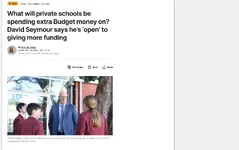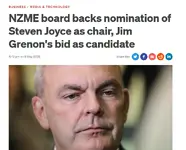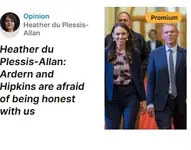The reference lost me. I had to Google. Was dimly aware she got booted for something, wasnt aware what.Well said Chloe
Navigation
Install the app
How to install the app on iOS
Follow along with the video below to see how to install our site as a web app on your home screen.
Note: This feature may not be available in some browsers.
More options
You are using an out of date browser. It may not display this or other websites correctly.
You should upgrade or use an alternative browser.
You should upgrade or use an alternative browser.
Politics 🗳️ NZ Politics
- Thread starter wizard of Tauranga
- Start date
Yes, I thought the mods might have given him a banWell said Chloe
*blows whistle* shit posting! 10 in the bin, kicked out of Parliament.Yes, I thought the mods might have given him a ban
And who the hell is Peter Puffer, can he play right wing?
He's a right wing homosexual so yes.And who the hell is Peter Puffer, can he play right wing?
Cut state services to the bone, slash help for those who need it most. Oh look, private industry gets public funding to help privatise state assets and services
Utterly corrupt, utterly hypocritical, proving once again that privatisation is the aim, profit for their mates is the aim, breaking community and democracy is the aim. It never was about the neoliberal mantra of choice.

Private schools got a boost of $4.6 million, upping their annual Government funding to $46.2m, announced in Budget 2025. Associate Education Minister David Seymour says he is open to that amount increasing, but what exactly is the money going towards?
At St Cuthbert’s College, a morning stroll across the school... grounds brings into view the well-groomed lawns, manicured trees and pale cream buildings.
It’s a short walk past the colonnaded main building to the principal’s office and this passing view of the campus exudes affluence.
The Auckland institution is just one of many private schools across the country getting a boost in funding from the Government.
There are 83 private schools in New Zealand, with a high concentration of them in Auckland, compared to 2450 state schools.
The multi-million dollar funding boost, announced in Budget 2025, is being driven by Associate Minister of Education David Seymour. He says the amount of money private schools receive has been shrinking, with the last increase to the subsidy coming in 2010.
The list of schools receiving the increased subsidy for 2026 will be made available next month by the Ministry of Education.
Seymour also says he’s “open” to the idea of the pot growing even more and explains that children at private schools receive around one-tenth of the funding of public-school students.
“Is that fair? Their parents are taxpayers, they’re New Zealand citizens, they’re entitled to an education. I think in a fair world, that would be higher,” Seymour told the Weekend Herald.
With a roll of 1650 students, St Cuthbert’s College is set to receive an estimated $1.6 million subsidy from the Government. The amount has increased by $160,000 on the previous per-student rate.
Principal Charlotte Avery, who took on the leader’s role at St Cuthbert’s last year after shifting from a prestigious private girls’ school in Cambridge, England, says in real terms the subsidy isn’t a large payment at a $100 increase per student.
“We are grateful of course for that recognition, but in the end it’s a very small part of supplementing our fee income,” Avery says.
“We recognise that we are a school of privilege – privilege is not a dirty word but it is important in terms of recognising responsibility.”
At co-educational private school Scots College in Wellington, headmaster Graeme Yule says the funding increase is “well overdue”. He also argues it shouldn’t become an ideological debate.
“It’s much, much easier to cry elitism and to cry inequality but the facts don’t match that, the finances are different,” Yule says.
“There will always be a perception in this that the Government’s robbing the poor state schools and giving the money to the rich independent schools ... but we receive around $40 million in government subsidy and we pay GST on fees to the Government of around $150 million.”
That tax on fees, Yule says, can be invested back into the state sector to support public school students.
Post Primary Teachers’ Association (PPTA) president Chris Abercrombie, however, sees another reason for the Government making this decision.
“Well, David Seymour’s [Epsom] electorate has a lot of private schools in it,” Abercrombie says.
In Abercrombie’s view, the Government’s focus should be firmly on supporting the public education system, and if parents choose to send their child to a private school then the state shouldn’t subsidise that decision.
“We don’t support private schools getting any subsidy at all, let alone an increased subsidy,” he says.
Figures provided by the Ministry of Education reveal the subsidy for Years 1-6 at private schools will be rising to $1016 per student – a 20% increase. That amount has increased by $167 per student. Older students from Years 11-13 will receive $1918 per student - an increase of just 6%.
Subsidy rates will not be recalculated each year but will be treated like other state school resourcing, with adjustments made for the number of students on private school rolls.
But Seymour says his decision hasn’t been influenced by private schools in his electorate, one of the country’s wealthiest, and the PPTA is “just flinging mud”.
In comparison, figures given to the Herald by Seymour’s office reveal the amount for Years 1-6 at state schools is $7648 per student annually, while the funding for secondary schools in the state system is $9853 per student.
At a small Porirua school nestled in native bush on the edge of Cannons Creek, principal Lynda Knight says she has been facing a list of government funding reductions during the last six months.
The school’s funding has been cut for its Reading Recovery programme, Pasifika Early Literacy Project and the Pacific Education Innovation Fund.
Funding has also been cut to Regionally Allocated Professional Learning and Development and te reo Māori training for teachers, so the school can no longer acquire these supports. And there is no longer access to Resource Teachers of Literacy and Māori.
They have also lost a whānau liaison support worker role that was funded by Oranga Tamariki.
Knight says the school, with just 110 primary-age students, can’t hold big parent and community fundraisers as some affluent areas can, and any fundraising initiatives only bring in small amounts of money.
“I think we’re increasing that disparity if we’re increasing the funding [for private schools]; we must be decreasing the amount of money for public schools like mine,” she says.
Abercrombie says disparities between public and private schools are creating a growing divide between the “haves and have-nots”.
Differences in the resources available to schools are exacerbating inequity across the education system, he says.
“State schools are facing that same cost pressure, their power’s gone up and the price of toilet paper – they’re hurting as well. But they don’t have the ability to just increase their fees and tap into other sources of income that private schools do.”
In Wellington, Yule says the private school subsidy is going to be used to keep fees as low as possible at Scots College and increase accessibility for the school. It will also go towards running costs.
Dilworth School in central Auckland is receiving the subsidy but because of its unique position with every student funded fully through a scholarship, the funds will be used elsewhere.
The money at the boys’ boarding school, headmaster Dan Reddiex says, will instead go towards offsetting the cost of food for students, investing in teachers, driving academic results and funding extracurricular activities such as sending their premier choir Fortissimo to the Big Sing Finale in Dunedin.
The school’s whānau community is not typically in a position to fully fund school trips, he says.
“We provide seven meals a day for our students and inflation has hit hard in this area.”
Meanwhile, Avery says the subsidy will support a range of ongoing projects at St Cuthbert’s College. These include enhancing its suite of facilities, improving flood resistance in the school’s buildings and paying teachers and staff members’ salaries.
It will also contribute to improving its outdoor campus – Kahunui – in the Bay of Plenty, a place where Year 10 students travel to attend a month-long school camp that embraces off-the-grid learning.
At Knight’s school in Porirua, Year 6 students used to travel to El Rancho in Waikanae – 45 minutes up the road – for a two-night camp. However, now that community funding is unavailable, the future of camps for their senior students is uncertain.
In a community where family holidays are a rarity, Knight says pupils leaving often comment that school camp is their favourite memory from school.
As Auckland grows, St Cuthbert’s College has been experiencing higher demand for places on its school roll and has waiting lists for prospective students.
Scots College has also been facing similar pressure, with headmaster Yule noticing parents are being propelled to private schools by their feeling of unease in the current state system.
“The issues with literacy and numeracy, open-plan classes and the dissatisfaction with NCEA and so forth, I think, have driven a number of people towards considering independent schooling.”
At Dilworth, Reddiex says demand for places has also increased significantly within the past two years, with scholarship places being highly competitive.
Similarly, Seymour says private school students suddenly flooding into the state sector would create an enormous cost for the Government.
“This whole debate to me says something about where we are and where we could be as a country. What you’ve got is a small group – about 4% of children and their parents and grandparents – often making big sacrifices to pay independent school fees because in their view, that’s a better future for them,” he says.
“Rather than...this kind of sneering, resentful tone, we should say, ‘okay, that’s a choice people make’, I may or may not make it for myself, but we should be happy for other people.
“Those people are actually saving the taxpayer a lot of money.”
In Porirua, Knight believes the $160,000 increase St Cuthbert’s College is receiving could make “a world of difference” at her small school. She says the money would go towards funding two more teachers or more teacher aide support.
Eva de Jong is a New Zealand Herald reporter covering general news for the daily newspaper, Weekend Herald and Herald on Sunday. She was previously a multimedia journalist for the Whanganui Chronicle, covering health stories and general news.
Sign up to The Daily H, a free newsletter curated by our editors and delivered straight to your inbox every weekday.
Utterly corrupt, utterly hypocritical, proving once again that privatisation is the aim, profit for their mates is the aim, breaking community and democracy is the aim. It never was about the neoliberal mantra of choice.

Private schools got a boost of $4.6 million, upping their annual Government funding to $46.2m, announced in Budget 2025. Associate Education Minister David Seymour says he is open to that amount increasing, but what exactly is the money going towards?
At St Cuthbert’s College, a morning stroll across the school... grounds brings into view the well-groomed lawns, manicured trees and pale cream buildings.
It’s a short walk past the colonnaded main building to the principal’s office and this passing view of the campus exudes affluence.
The Auckland institution is just one of many private schools across the country getting a boost in funding from the Government.
There are 83 private schools in New Zealand, with a high concentration of them in Auckland, compared to 2450 state schools.
The multi-million dollar funding boost, announced in Budget 2025, is being driven by Associate Minister of Education David Seymour. He says the amount of money private schools receive has been shrinking, with the last increase to the subsidy coming in 2010.
The list of schools receiving the increased subsidy for 2026 will be made available next month by the Ministry of Education.
Seymour also says he’s “open” to the idea of the pot growing even more and explains that children at private schools receive around one-tenth of the funding of public-school students.
“Is that fair? Their parents are taxpayers, they’re New Zealand citizens, they’re entitled to an education. I think in a fair world, that would be higher,” Seymour told the Weekend Herald.
With a roll of 1650 students, St Cuthbert’s College is set to receive an estimated $1.6 million subsidy from the Government. The amount has increased by $160,000 on the previous per-student rate.
Principal Charlotte Avery, who took on the leader’s role at St Cuthbert’s last year after shifting from a prestigious private girls’ school in Cambridge, England, says in real terms the subsidy isn’t a large payment at a $100 increase per student.
“We are grateful of course for that recognition, but in the end it’s a very small part of supplementing our fee income,” Avery says.
“We recognise that we are a school of privilege – privilege is not a dirty word but it is important in terms of recognising responsibility.”
At co-educational private school Scots College in Wellington, headmaster Graeme Yule says the funding increase is “well overdue”. He also argues it shouldn’t become an ideological debate.
“It’s much, much easier to cry elitism and to cry inequality but the facts don’t match that, the finances are different,” Yule says.
“There will always be a perception in this that the Government’s robbing the poor state schools and giving the money to the rich independent schools ... but we receive around $40 million in government subsidy and we pay GST on fees to the Government of around $150 million.”
That tax on fees, Yule says, can be invested back into the state sector to support public school students.
Post Primary Teachers’ Association (PPTA) president Chris Abercrombie, however, sees another reason for the Government making this decision.
“Well, David Seymour’s [Epsom] electorate has a lot of private schools in it,” Abercrombie says.
In Abercrombie’s view, the Government’s focus should be firmly on supporting the public education system, and if parents choose to send their child to a private school then the state shouldn’t subsidise that decision.
“We don’t support private schools getting any subsidy at all, let alone an increased subsidy,” he says.
Figures provided by the Ministry of Education reveal the subsidy for Years 1-6 at private schools will be rising to $1016 per student – a 20% increase. That amount has increased by $167 per student. Older students from Years 11-13 will receive $1918 per student - an increase of just 6%.
Subsidy rates will not be recalculated each year but will be treated like other state school resourcing, with adjustments made for the number of students on private school rolls.
But Seymour says his decision hasn’t been influenced by private schools in his electorate, one of the country’s wealthiest, and the PPTA is “just flinging mud”.
In comparison, figures given to the Herald by Seymour’s office reveal the amount for Years 1-6 at state schools is $7648 per student annually, while the funding for secondary schools in the state system is $9853 per student.
At a small Porirua school nestled in native bush on the edge of Cannons Creek, principal Lynda Knight says she has been facing a list of government funding reductions during the last six months.
The school’s funding has been cut for its Reading Recovery programme, Pasifika Early Literacy Project and the Pacific Education Innovation Fund.
Funding has also been cut to Regionally Allocated Professional Learning and Development and te reo Māori training for teachers, so the school can no longer acquire these supports. And there is no longer access to Resource Teachers of Literacy and Māori.
They have also lost a whānau liaison support worker role that was funded by Oranga Tamariki.
Knight says the school, with just 110 primary-age students, can’t hold big parent and community fundraisers as some affluent areas can, and any fundraising initiatives only bring in small amounts of money.
“I think we’re increasing that disparity if we’re increasing the funding [for private schools]; we must be decreasing the amount of money for public schools like mine,” she says.
Abercrombie says disparities between public and private schools are creating a growing divide between the “haves and have-nots”.
Differences in the resources available to schools are exacerbating inequity across the education system, he says.
“State schools are facing that same cost pressure, their power’s gone up and the price of toilet paper – they’re hurting as well. But they don’t have the ability to just increase their fees and tap into other sources of income that private schools do.”
In Wellington, Yule says the private school subsidy is going to be used to keep fees as low as possible at Scots College and increase accessibility for the school. It will also go towards running costs.
Dilworth School in central Auckland is receiving the subsidy but because of its unique position with every student funded fully through a scholarship, the funds will be used elsewhere.
The money at the boys’ boarding school, headmaster Dan Reddiex says, will instead go towards offsetting the cost of food for students, investing in teachers, driving academic results and funding extracurricular activities such as sending their premier choir Fortissimo to the Big Sing Finale in Dunedin.
The school’s whānau community is not typically in a position to fully fund school trips, he says.
“We provide seven meals a day for our students and inflation has hit hard in this area.”
Meanwhile, Avery says the subsidy will support a range of ongoing projects at St Cuthbert’s College. These include enhancing its suite of facilities, improving flood resistance in the school’s buildings and paying teachers and staff members’ salaries.
It will also contribute to improving its outdoor campus – Kahunui – in the Bay of Plenty, a place where Year 10 students travel to attend a month-long school camp that embraces off-the-grid learning.
At Knight’s school in Porirua, Year 6 students used to travel to El Rancho in Waikanae – 45 minutes up the road – for a two-night camp. However, now that community funding is unavailable, the future of camps for their senior students is uncertain.
In a community where family holidays are a rarity, Knight says pupils leaving often comment that school camp is their favourite memory from school.
As Auckland grows, St Cuthbert’s College has been experiencing higher demand for places on its school roll and has waiting lists for prospective students.
Scots College has also been facing similar pressure, with headmaster Yule noticing parents are being propelled to private schools by their feeling of unease in the current state system.
“The issues with literacy and numeracy, open-plan classes and the dissatisfaction with NCEA and so forth, I think, have driven a number of people towards considering independent schooling.”
At Dilworth, Reddiex says demand for places has also increased significantly within the past two years, with scholarship places being highly competitive.
Discover more
- 'World-leading': New 250-student private school planned ...
- Are private schools better than public schools in New ...
- 'Hypocrisy': Education Minister calls out Willie Jackson ...
- The cost of a private school education: NZ’s most expensive ...
Similarly, Seymour says private school students suddenly flooding into the state sector would create an enormous cost for the Government.
“This whole debate to me says something about where we are and where we could be as a country. What you’ve got is a small group – about 4% of children and their parents and grandparents – often making big sacrifices to pay independent school fees because in their view, that’s a better future for them,” he says.
“Rather than...this kind of sneering, resentful tone, we should say, ‘okay, that’s a choice people make’, I may or may not make it for myself, but we should be happy for other people.
“Those people are actually saving the taxpayer a lot of money.”
In Porirua, Knight believes the $160,000 increase St Cuthbert’s College is receiving could make “a world of difference” at her small school. She says the money would go towards funding two more teachers or more teacher aide support.
Eva de Jong is a New Zealand Herald reporter covering general news for the daily newspaper, Weekend Herald and Herald on Sunday. She was previously a multimedia journalist for the Whanganui Chronicle, covering health stories and general news.
Sign up to The Daily H, a free newsletter curated by our editors and delivered straight to your inbox every weekday.
Hahaha, have you handed back your subscription?
I've met Aud a few times through her brother and I would say she's more a centrist and not afraid to call out either side.
Of course there's no front page on Palestine, Chloe sucked up all the headline by being a narcissist dumb arse.
I've met Aud a few times through her brother and I would say she's more a centrist and not afraid to call out either side.
Of course there's no front page on Palestine, Chloe sucked up all the headline by being a narcissist dumb arse.

Sudan’s calamity and ‘the end of the liberal world order’
Analysis: The war and its suffering is an indictment of a faltering international system.
Don't hear much wailing and gnashing of teeth over this situation?
That's another one being ignored, a terrible situation
Sudan’s calamity and ‘the end of the liberal world order’
Analysis: The war and its suffering is an indictment of a faltering international system.www.nzherald.co.nz
Don't hear much wailing and gnashing of teeth over this situation?
- Thread starter
- #18,931
Mate, there’s wars and atrocities happening all over the world all the time.That's another one being ignored, a terrible situation
Why is Palestine more important than all the others to you?
Personally I do care but it’s all foreign involving issues long before I was born, that smarter people than us can’t resolve and I can’t see any easy outcome.
I prefer to worry about issues I understand and that influence my life so I have a tie to it and have some relevant knowledge.
Good on Chloe for caring but she’s irrelevant in the big global picture and just being populist (eg we hear nothing on the other atrocities happening). Our politicians need to take stands on issues at home.
Not fashionable
Sudan’s calamity and ‘the end of the liberal world order’
Analysis: The war and its suffering is an indictment of a faltering international system.www.nzherald.co.nz
Don't hear much wailing and gnashing of teeth over this situation?
- Thread starter
- #18,933
Who are these rich mates?profit for their mates is the aim, breaking community and democracy is the aim.
Housing has crashed, the stock market (big business) is down under National. Small businesses are closing left right and centre.
Can you back it up with who these rich mates are because no one is richer at the moment and if anything National has focused on affordability, productivity and realigning the economy for middle New Zealanders to the detriment of asset and capital holders.
Gosh just imagine the wailing and gnashing of teeth if Labour and/or the Greens had thrown away so much money based on ideological reasons
View: https://bsky.app/profile/drdrehistorian.bsky.social/post/3lwfxej72rs2m
View: https://bsky.app/profile/drdrehistorian.bsky.social/post/3lwfxej72rs2m
Good self awareness again FrankNot fashionable
The rotten conspiracy disinformation world of NZ First
View: https://bsky.app/profile/shakingstick.bsky.social/post/3lwkgjmv63k2w
View: https://bsky.app/profile/shakingstick.bsky.social/post/3lwkgjmv63k2w
Trick in this one is actually picking a sideNot fashionable
Not popular right now. The serial protesters’ instagram algorithms are swept up by only one issue at any one time
Sudan’s calamity and ‘the end of the liberal world order’
Analysis: The war and its suffering is an indictment of a faltering international system.www.nzherald.co.nz
Don't hear much wailing and gnashing of teeth over this situation?
Similar threads
Current Affairs
🗳️ Is this the twilight of democracy?
- Replies
- 160
- Views
- 30K
- Replies
- 3
- Views
- 3K



